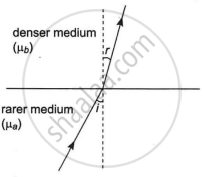Advertisements
Advertisements
प्रश्न
Define the critical angle for a given pair of media and total internal reflection. Obtain the relation between the critical angle and refractive index of the medium.
उत्तर
The angle of incidence corresponding to an angle of refraction of 90° is called the critical angle for the given pair of media. If the angle of incidence of light, when travelling from a denser medium to a rarer medium, is greater than the critical angle then total internal reflection takes place.

Let the angle of incidence i and C be the critical angle C.
Let the angle of refraction r = 90°.
The refractive index of the rarer medium is μa.
The refractive index of the denser medium is μb.
Applying Snell's law,
`(sini)/(sinr) = mu_a/mu_b`
μb sinC = μa sin90° ....[∵ i = C and r = 90°]
`mu_a/mu_b = 1/(sinC)`
Thus, we arrive at a formula expressing the critical angle and refractive index relation:
`""_amu_b = 1/(sinC)`
APPEARS IN
संबंधित प्रश्न
A slide projector has to project a 35 mm slide (35 mm × 23 mm) on a 2 m × 2 m screen at a distance of 10 m from the lens. What should be the focal length of the lens in the projector?
A particle executes a simple harmonic motion of amplitude 1.0 cm along the principal axis of a convex lens of focal length 12 cm. The mean position of oscillation is at 20 cm from the lens. Find the amplitude of oscillation of the image of the particle.
A converging lens of focal length 15 cm and a converging mirror of focal length 10 cm are placed 50 cm apart with common principal axis. A point source is placed in between the lens and the mirror at a distance of 40 cm from the lens. Find the locations of the two images formed.
A converging lens of focal length 15 cm and a converging mirror of focal length 10 cm are placed 50 cm apart. If a pin of length 2.0 cm is placed 30 cm from the lens farther away from the mirror, where will the final image form and what will be the size of the final image?
A point object is placed at a distance of 15 cm from a convex lens. The image is formed on the other side at a distance of 30 cm from the lens. When a concave lens is placed in contact with the convex lens, the image shifts away further by 30 cm. Calculate the focal lengths of the two lenses.
Use the above relation to obtain the condition on the position of the object and the radius of curvature in terms of n1and n2 when the real image is formed.
According to new Cartesian sign conventions, all the distances are measured from the ______.
A point object in the air is placed symmetrically at a distance of 60 cm in front of a concave spherical surface with a refractive index of 1.5. If the radius of curvature of the surface is 20 cm, find the position of the image formed.
Obtain an expression for refraction at a single convex spherical surface, i.e., the relation between μ1 (rarer medium), μ2 (denser medium), object distance u, image distance v and the radius of curvature R.
Assertion: If critical angle of glass-air pair `("μg" = 3/2)` is θ1 and that of water-air pair `("μw" = 4/3)` is θ2, then the critical angle for the water-glass pair will lie between θ1 and θ2.
Reason: A medium is optically denser if its refractive index is greater.
